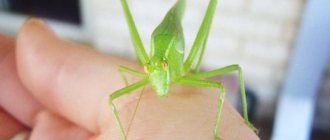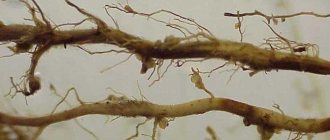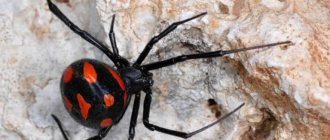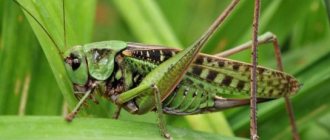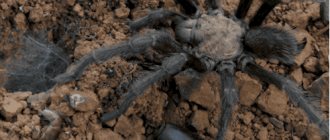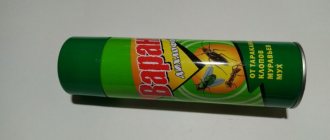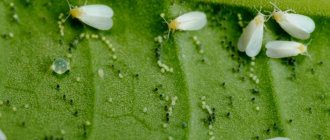Nature endows its creations with many amazing properties, one of the most interesting and amazing is glow. Fireflies, beetles from the family of the same name, have the characteristic feature of emitting light. The largest number of species live in tropical latitudes, but in the temperate zone beacons light up at night. Ivanov's worm is the name given to the common firefly in Russia. Females of this species signal invitingly with a greenish lantern on their abdomen. In the darkness of the night, on the edge of a forest, clearing or lake shore, you can see lonely lights.
firefly beetle
Firefly beetle (lat. Lampyris noctiluca, English Glow-worm) The common firefly or Ivan's worm is a beetle, a characteristic feature of which is the presence of luminescent organs on the last abdominal segments. The luminescent organs are most often located under the transparent cuticle and are formed by large photogenic cells, which are abundantly intertwined with trachea and nerves. Beneath these cells are light reflectors - cells filled with uric acid crystals. The trachea supplies photogenic cells with oxygen, which is necessary for the oxidative processes occurring here.
Distributed throughout Europe and Asia, also found in North America. It received its common name because of the belief that it appears for the first time of the year on the night of Ivan Kupala. Only females awaiting males on the ground or vegetation glow brightly; males practically do not emit light. Females emit a soft phosphorescent light in the dark, which serves as a means of attracting and detecting a sexual partner.
Adult beetles do not feed and die soon after mating and laying eggs. The eggs laid by the female hatch into predatory larvae whose main food is terrestrial mollusks. The larvae overwinter and emerge from wintering at the end of spring, and adult beetles appear at the beginning of summer. Fireflies can be seen on forest edges, damp glades, on the banks of forest lakes and streams.
The males of these beetles have a cigar-shaped body, up to 15 mm long, and a rather large head with large hemispherical eyes. They fly well. Females, in appearance, resemble larvae, have a worm-like body up to 18 mm long, and are wingless.
The glow of fireflies is caused by the chemical process of bioluminescence in their body. Light is emitted when intracellular oxygen combines with calcium, the energy storage molecule adenosine triphosphate (ATP), and the pigment luciferin in the presence of the enzyme luciferase. Luciferase is a protein rich in sulfhydryl groups. Unlike incandescent lamps, which produce a large amount of heat, fireflies emit “cold light”; from 87 to 98% of the energy is transferred into light rays.
To “turn on” the light, the organ that controls the glow begins to supply oxygen to other compounds necessary to generate light, and to “turn off” it stops supplying it. When there is oxygen, the luminescent organ emits light, and when there is no oxygen, it goes out. Insects do not have lungs, and oxygen from outside is supplied to the body through a complex system of gradually narrowing tubes called tracheoles. The muscles that control the supply of oxygen from the tracheoles work rather slowly, and the rapid activation of the glow has long remained a mystery.
However, scientists have recently discovered that nitric oxide plays a key role. Typically, all the oxygen needed by organelles to generate energy in cells is retained by mitochondria. To force the mitochondria to give up some of the oxygen, the insect's brain gives a command to produce nitric oxide, which replaces the oxygen in the mitochondria. The oxygen it displaces goes to the organs of luminescence and can be used in chemical reactions, as a result of which light is emitted. However, nitric oxide quickly decomposes, so oxygen soon binds again and light generation stops.
Adults flicker in a certain way, specific to each of them, which allows their sexual partners to distinguish them from others. Fireflies emit almost all signals that are in one way or another connected with sexual behavior, protective and territorial signals: be it calling and searching signals of males, signals of “agreement”, “refusal” and “post-copulatory” signals of females, as well as signals of aggression and even light mimicry.
Significant research has been carried out to study the behavior of lower fireflies. They have a glow that does not at all serve to attract winged males. Their main attracting factor is the smell, and therefore it remains to be seen why these fireflies glow. The role of light organs is reliably known only for the most evolutionarily developed forms.
Photo of firefly beetle Video of firefly beetle
A colony of fireflies was filmed in 2012 in the reeds on the island of Vlieland in the Dutch province of Friesland, one of the Frisian Islands. In the video there are about five thousand insects in an area of 30x8 meters, a passage to a small pond.
/wp-content/uploads/2016/12/svetlyachok.mp4
Nutrition and lifestyle
The common firefly received its popular name because, according to legend, it appears for the first time in the year on the night of Ivan Kupala. Although insects can be observed from the second half of May until July. As soon as it gets dark, the males go in search of partners, who spend the day in underground shelters, and when darkness falls, they climb onto tall blades of grass and invitingly turn on their flashlight. Light is emitted when a special substance, luciferin, is oxidized. Interestingly, the rhythm of blinking allows female fireflies to distinguish males of their own species from strangers. Adults of both male and female fireflies do not feed at all, using the reserves accumulated during the period spent in the larval stage. They have only one purpose - to leave offspring.
Phylloxera
Phylloxera literally means destructive aphid. In a short period of time, a microscopic insect can cause irreparable damage to vineyards. Its root forms are especially harmful. Appearing in Western Europe, the phylloxera crisis of the 60s of the twentieth century hit wine producers of grapevines the hardest. Many bankrupt French winegrowers took their own lives, without even waiting for the complete destruction of the vineyards.
A grape leaf affected by phylloxera.
Phylloxera damages the above-ground and underground parts of the grapevine. Quarantine harmfulness is associated with the fact that in order to undergo a certain development cycle, aphids overwinter on underground organs of the crop, including on the roots. To feed, root phylloxera larvae need space to move. Therefore, the root form of phylloxera multiplies especially quickly on the roots of grapevines cultivated on breathable, loose soils. Compacted soils that are poorly permeable to water and air are not suitable for root aphids. It does not settle on the roots of vineyards cultivated on sandy soils.
The hatched larvae stick to the roots, pierce the integumentary layer and suck out the juices of the plant. The female root form of the aphid forms 6-9 generations during the growing season, laying up to 400 eggs each time. The bark tissues, under the influence of phylloxera salivary enzymes, become ulcerated and tumor-like growths grow, into which soil bacteria and fungi penetrate. The root system begins to rot. After 4-5 years the bush dies.
Grape phylloxera, or ravage aphid on grape roots. Joachim Schmid
The leaf form of aphids damages the above-ground mass of garden, vegetable crops and vineyards, settling mainly on leaves and young shoots. When grape leaves are infected, galls (swells) form on the underside, in which aphid larvae develop. Maximum reproduction of aphids occurs in August-September. If protective measures are not taken in a timely manner, aphids can reduce the yield on grape plantations by 20-30%.
Methods of protection against phylloxera
Preventive protective measures are to purchase planting material only of zoned varieties, and grafted only on phylloxera-resistant rootstocks. Purchasing from unfamiliar producers or temporary markets can cause infection of healthy grape bushes with phylloxera.
When vaccinations are carried out independently, it is necessary to comply with all sanitary requirements when performing vaccination work. The best rootstocks are: Riparia Glouar, Kober 5BB, Riparia x Rupestris 101-14. The root system of these rootstocks in places where they are punctured by aphids is not susceptible to putrefactive processes. The bush continues to grow and develop normally, producing high yields of good quality for a long time.
An exposed gall with a clutch of eggs and phylloxera larvae. Joachim Schmid
Among the effective chemical preparations for leaf forms of phylloxera are Fastak, BI-58, Actellik, Konfidor, Decis, Alatar, Karate, Inta-Vir and others, which must be used strictly according to the instructions. The first treatment with drugs is carried out in the first triad of May during the development phase of 1-2 leaves, the second in the third when 12-14 leaves are deployed on a young shoot, the third no later than the second half of June. During the rest of the period, if it is necessary to protect against August aphids, it is necessary to switch to protective measures using biological products that are harmless to people and animals.
Among the biological products with a wide spectrum of action on a complex of pests, Lepidocide, Entobacterin, Fitoverm (aversectin), Iskra-bio, Agravertin, Akarin are recommended. The use of biological products is permitted until the harvest begins to ripen.
Why do fireflies glow?
Most members of the firefly family are known for their ability to emit a phosphorescent glow, which is especially noticeable in the dark. In some species, only males can glow, in others, only females, in others, both (for example, Italian fireflies). Males emit a bright light in flight. Females are inactive and usually glow brightly on the soil surface. There are also fireflies that do not have this ability at all, while in many species the light comes even from the larvae and eggs.
By the way, few sushi animals even exhibit the phenomenon of bioluminescence (chemical glow). The larvae of fungus gnats, springtails (collembolas), fire flies, jumping spiders and representatives of beetles, for example, such as fire-bearing click beetles (pyrophorus) from the West Indies, are known to be capable of this. But if we count marine inhabitants, then there are at least 800 species of luminous animals on Earth.
Photo by: Nevit Dilmen, CC BY-SA 3.0
The organs that allow fireflies to emit rays are photogenic cells (lanterns), abundantly intertwined with nerves and tracheas (air tubes). Externally, lanterns look like yellowish spots on the underside of the abdomen, covered with a transparent film (cuticle). They can be located on the last segments of the abdomen or evenly distributed throughout the body of the insect. Beneath these cells lie others filled with uric acid crystals and capable of reflecting light. Together, these cells work only if there is a nerve impulse from the insect’s brain. Oxygen enters the photogenic cell through the trachea and, with the help of the enzyme luciferase, which accelerates the reaction, oxidizes the compound of luciferin (light-emitting biological pigment) and ATP (adenosine triphosphoric acid). Thanks to this, the firefly glows, emitting light of blue, yellow, red or green.
Males and females of the same species most often emit rays of similar colors, but there are exceptions. The color of the glow depends on the temperature and acidity (pH) of the environment, as well as on the structure of luciferase.
Photogenic cells. Photo credit: National Park Service, Public Domain
The beetles themselves regulate the glow; they can strengthen or weaken it, make it intermittent or continuous. Each species has its own unique phosphorus radiation system. Depending on the purpose, the glow of fireflies can be pulsating, flashing, stable, fading, bright or dim. The female of each species reacts only to the male’s signals with a certain frequency and intensity of light, that is, his mode. With a special rhythm of light emission, beetles not only attract partners, but also scare away predators and protect the boundaries of their territories. There are:
- search and calling signals in males;
- signals of consent, refusal and post-copulatory signals in females;
- signals of aggression, protest and even light mimicry.
Interestingly, fireflies spend about 98% of their energy emitting light, while an ordinary electric light bulb (incandescent lamp) converts only 4% of the energy into light, the rest of the energy is dissipated as heat.
Diurnal fireflies often do not need the ability to emit light, which is why they lack it. But those daytime representatives who live in caves or dark corners of the forest also turn on their “flashlights”. The eggs of all types of fireflies also emit light at first, but it soon fades away. During the day, the light of a firefly can be seen if you cover the insect with two palms or move it to a dark place.
By the way, fireflies also give signals using the direction of flight. For example, representatives of one species fly in a straight line, representatives of another species fly in a broken line.
Firefly Lamprohiza splendidula. Photo by: Kryp, CC0
Common firefly, or lantern firefly (Lampyrus noctiluca L.)
Some insects have the amazing ability to glow. Their number is small and limited to only a few groups, such as springtails, fungus gnat larvae and representatives of a number of families of the order Coleoptera. The ability to glow is most strongly developed in beetles. The most characteristic in this regard are fireflies.
Fireflies are often classified as a separate family, Lampyriclae. But more often than not they are classified as soft-bodied animals. In total, about 2 thousand species of fireflies are known in the world fauna.
These truly soft-bodied beetles are distributed mainly in the subtropics and tropics. Although they are all called fireflies, not every species has luminescent organs. There are a few among them that are active during the day. Naturally, they do not need luminous organs. Those that are active at night and have an amazing ability to glow differ in character and, so to speak, mode of glow. In some species, such organs are developed in both sexes, in others - only in females, in others - only in males.
Our fireflies, of which there are 12 species in Russia and neighboring countries, are not much inferior to “tropical lamps”: they produce quite strong light.
In most cases, the light color of beetles is dominated by blue and green tones. The light emitted by insects covers wavelengths from 486 to 656 millimicrons. This area is small and very effective for human eyes. The release of heat during glowing is negligible, and, for example, in pyrophorus, 98% of the expended energy is converted into light. For comparison, let us recall that in conventional incandescent light bulbs, no more than 4% of the consumed electricity is utilized.
Scientists have spent a lot of effort to disassemble the structure of the organs of luminescence and understand its mechanism. The luminous organ consists of a mass of multifaceted cells with very thin transparent walls, inside of which there is a fine-grained mass. Between such cells, air tubes branch in large numbers. The reason for the glow is the oxidation of the contents of these cells with oxygen, which is delivered to them by the mentioned tubes. The luminous organs also include the fat body. It is believed that the luminescence of photogenic cells is associated with an oxidative process of an enzymatic nature: a special substance, luciferin, is oxidized into oxyluciferin in the presence of the enzyme luciferase. This process is accompanied by luminescence and is controlled by the nervous system.
The biological significance of luminescence has not been sufficiently studied. It is natural to assume that it serves to bring the sexes closer together. Or a signal when food is detected, since several individuals often gather for a meal at the same time. In most cases, the female shines brighter than the male. The latter are usually smaller than females, do not feed or hardly feed, and die soon after several matings.
Subtropical firefly species are larger than ours and fly well. As a rule, beetles of both sexes emit light. This is how A. Bram describes this spectacle: “These bugs gather in large groups on the banks of rivers overgrown with bushes. On a dark summer moonless night they present a delightful sight. They fly from place to place with sparkling sparks, but with the onset of morning they go out, and the worms themselves become invisible, hiding somewhere in the grass.”
Those who have been to the Black Sea coast of the Caucasus and did not limit themselves to visiting beaches and embankments can remember how in the evenings in the secluded alleys of parks and in shaded squares, periodically flashing, silently, like magical elves, these amazing creatures flutter.
Adults and larvae of almost all fireflies are active and voracious predators: they feed on insects or mollusks, although they can attack earthworms and caterpillars of cutworm butterflies. Some species develop under the bark and in the wood of rotting trees. Adults are often found on flowers.
Spreading. The common firefly is widespread throughout the European part of Russia (except for the north), as well as in the Crimea, the Caucasus, Siberia and the Far East. About 100 years ago it could often be found in Moscow, on the territory of modern Neskuchny Garden. Here is a description of Neskuchny at the time when the garden belonged to Prince Shakhovsky: “From the middle of the bridge a gorge opened onto a gorge, covered with forest, gloomy and deep. The hundred-year-old trees growing at its bottom seem like saplings. Their roots are washed by a barely noticeable stream that forms a small pond on the other side of the bridge. There are numerous snakes in the fat, there are bats, and fireflies sparkle at night.” Unfortunately, now there is no hope of meeting this amazing insect in the center of Moscow. To do this, you should go to more remote places.
External signs. The common firefly is small in size; its body is flattened and covered with small hairs. Looking at the dark brown female, you would never think that this is a beetle. It is inactive, completely devoid of wings and elytra, and resembles a larva, from which it differs only in its wider chest shield. The head is completely hidden under the rounded neck shield, the antennae are thread-like. Luminous organs in the form of yellowish spots are located on the underside of the two penultimate abdominal segments. In the dark they emit a bright greenish light. Interestingly, the eggs laid by the female also emit a dim glow at first, but soon this light fades away.
The larva of the common firefly has a very small head. The last segment of the abdomen bears a retractile brush, consisting of a double ring of cartilaginous rays. With its help, the larva removes mucus and earth particles from its body that stick to it. This is absolutely necessary for her, since she feeds (as, indeed, often adults) on slugs and snails, which are covered in abundance with mucus.
Lifestyle. Mating occurs on the soil surface or on low plants and often lasts 1 - 3 hours. The female is capable of laying up to 100 eggs. She hides them in depressions in the soil, in moss or in various debris.
The development and feeding of the larvae emerging from them lasts several months. At the larval stage, the firefly usually overwinters. The pupa forms in the soil in the spring. After a week or two, a beetle comes out of it. The entire life cycle of a firefly lasts 1 - 2 years.
Some authors write that, when disturbed, fireflies stop glowing. My personal experience with the common firefly does not allow me to agree with such a statement. Somehow I needed to find several specimens of these beetles for photography. Attempts to detect them in the immediate Moscow region were unsuccessful. Neither my friends and acquaintances, nor I myself have ever met them here. But whoever seeks will always find! Our meeting took place on the edge of a forest on a dark June midnight in the Yaroslavl region. (By the way, the popular name of the firefly Ivan's worm is probably explained by the fact that it is most often found at the end of June, when Midsummer Day - Ivan Kupala - was widely celebrated in Rus').
For several days before this there had been sweltering heat, which, as it should be at this time, ended one day with thunderous rain. After this thunderstorm, I walked through the forest from the highway to my village. And so, crossing a small field overgrown with young birch trees, over which small white clouds of vapor fluttered like ghosts, I suddenly saw bright lights in the grass. Fireflies! Of course it was them. It's good that I had a flashlight with me. Otherwise it would be difficult to collect them. I immediately took off my backpack and started getting ready. The light coming from the female was not enough to illuminate her. I squatted down near the luminous point, carefully parted the grass and directed the flashlight beam at it. Here the entire slightly crooked, larval-like wingless female was visible. She tenaciously held onto the blade of grass with her feet, clearly not wanting to part with it. Indeed, waiting was her lot. Waiting for the gentleman. Near some of the females there were also males - slender, I would say, elegant beetles, equipped with full-fledged elytra. This was especially useful since I needed individuals of both sexes. It would be simply impossible to find males without females: after all, although they have luminescent organs, they practically do not emit light. From a fairly large number of beetles glowing around, I selected only a few pairs and placed them in a jar. At the same time, the males did not show the slightest desire to escape from my fingers and fly away. I knew that, although they are winged, they fly rarely and reluctantly.
That night I discovered that those who believe that disturbed fireflies stop emitting light are wrong. During my hunt, some females fell to the ground. But they never stopped glowing for a moment, which made it easier to find them in the grass. Moreover, the glow continued even after the caught beetles ended up in a glass jar. They glowed inside her for a long time, both on the way home and home. In complete darkness, 5 - 6 females emitted enough light to make out the text of a book brought to this amazing lamp.
Role in nature. The common firefly is a very characteristic inhabitant of wooded areas, inhabiting forest edges, clearings, roadsides, banks of lakes and streams. Here, in damp places, it easily finds its main food - terrestrial mollusks, which it destroys in abundance.
The character and lifestyle of the firefly
The most typical representatives of insects living in our latitudes include the fireweed worm. This firefly lives in the forest, being active at night during the warm season.
Representatives of these insects spend the day hidden in thick grass. Females have a long, segmented body, a brownish-brown color with three white stripes on the abdomen, they are not capable of flight, and they do not have wings. In appearance they resemble larvae, about 18 mm long.
Such insects are capable of completely magically transforming the forest, lighting their lanterns across the grass and bushes, flashing brightly and going out. Such flickering of fireflies is an unforgettable sight. Some of them, those that glow more dimly, fly into the air and maneuver past the trees.
And then, in a breathtaking whirlwind, they rush down like the rockets of night fireworks. These male fireflies discovered their girlfriends and rushed into the grass closer to them.
Male representatives of insects have a cigar-shaped body about one and a half centimeters long, a large head and large hemispherical eyes. Unlike females, they fly beautifully.
Representatives of these insects from the genus Luciola, which have settled in the Caucasus, glow with short flashes every one or two seconds, with similar maneuvers reminiscent of the photinus beetle from North America.
Sometimes fireflies emit a longer light in flight, like shooting stars, flying and dancing lights against the backdrop of the southern night. In history there are interesting facts about the use of fireflies by people in everyday life.
For example, chronicles indicate that the first white settlers, who sailed to Brazil on sailing ships, where fireflies also live, illuminated their homes with natural light.
And the Indians, when going hunting, tied these natural lanterns to their toes. And bright insects not only helped to see in the dark, but also scared away poisonous snakes. This feature of fireflies is sometimes compared in properties to a fluorescent lamp.
However, this natural glow is much more convenient, because by emitting their lights, insects do not heat up and do not increase body temperature. Of course, nature took care of this, otherwise it could lead to the death of fireflies.
Description
The common firefly is a small insect - 12-18 mm. Females are inactive, more like a dark brown larva. Their wings are reduced. At the end of the abdomen there is an organ that emits a bright greenish light. Males have a cigar-shaped body and a large head with large hemispherical eyes. The wings are tender and flexible, well developed.
Appearance and features
Photo: What locusts look like
By nature, the locust has an elongated body and six legs, two of which, namely the front ones, are weak. One back is longer than the other and many times stronger. In nature, there are individuals whose body length reaches fifteen centimeters. Typically, the body length ranges from 3 to 7 cm. The locust also has a large head with pronounced eyes.
The wings are transparent and practically invisible when folded and are covered with two solid elytra. Locusts are one of the oldest representatives of the Orthoptera order. There are about twenty thousand species around the world. The color of the locust depends only on the place where it lives and where it was formed. Therefore, specimens that appeared at the same time from the same female can be completely different colors, provided that they are raised in different conditions.
The appearance of locusts largely depends on the stage of their formation. The color of singles is a camouflage suit of green-yellow or walnut color. The shade depends entirely on the region of residence of such an insect. When a flock is formed, all its members become similar to each other. There are no differences between individuals, including no division by gender. Locusts can cover a distance of 200 km in a day. Some types of locusts are very similar to grasshoppers. Therefore, at first glance, it is difficult to recognize a pest in such individuals. A mistake in this case can be costly, especially for agricultural producers.
Therefore, you should pay attention to the signs by which it is easy to distinguish a locust from a grasshopper:
- the body of the locust is longer than the body of the blacksmith;
- the locust's snout is rectangular in shape, while that of the grasshopper is elongated;
- the locust's antennae are quite short in relation to its head;
- the front legs of the locust are much less developed than the hind legs;
- Grasshoppers are lovers of the evening cool, so they lead an active life in the evening. The locust, on the contrary, loves daylight very much, so it is active during daylight hours;
- grasshoppers never gather in flocks, while locusts, on the contrary, are most often found in the company of their relatives.
Symptoms of the lesion
The first sign of beetles in the garden is gumming on conifers and the appearance of gum on stone fruit trees. These symptoms are a kind of natural protection of strong plants from bark beetles - in this way they heal the holes that appeared as a result of pest attacks.
On deciduous trees you can see drill flour - light brown sawdust - next to small holes. When you remove part of the bark at this place, you can see the passages made by the beetle when arranging the nest.
If no measures are taken after detecting bark beetles, their larvae can damage the tree’s nutrition system so much that the foliage or needles begin to wither and then fall off. The bark will also dry out and peel off. All this will lead to the inevitable death of the tree.
Reproduction, offspring and lifespan of the firefly beetle
As mentioned earlier, fireflies attract mates of the opposite sex with their light and mate with them. When the male beetle enters mating season, he goes out to look for a mate and it is at this time that she notices her chosen one by the shade of light
The brighter the light, the more popular the male is and the females pay the most attention to him.
During the mating season, some species of fireflies stage real light shows in which entire groups of beetles participate. It looks more beautiful than the night lights of a big city.
When the female gives the male a certain signal that she has chosen him, he comes down to her and they communicate for a few more minutes, glowing with lights, after which the fertilization process itself occurs. After copulation, the female lays eggs, from which beetle larvae
. They are mostly black or yellow. There are terrestrial and aquatic larvae.
eat small invertebrates in huge quantities.
, as well as shellfish. They can glow just like adult beetles. Having eaten in the summer, they hide in the trees for the winter and spend the winter there.
In early spring, the larvae wake up and again eat in huge quantities. This happens for about a month or longer, after which the process of pupation of the larva
, which lasts from 7 to 18 days.
As a result, an adult beetle appears, which, like the others, will glow on a dark summer night with its bewitching light. Adults do not live long, about three to four months.
On a summer night, fireflies present a bewitching and wonderful sight when, as in a fairy tale, colorful lights twinkle like little stars in the darkness.
Their light comes in red-yellow and green shades, of varying duration and brightness. firefly insect
belongs to the order Coleoptera, a family that contains about two thousand species, distributed in almost all parts of the world.
The most striking representatives of insects settled in the subtropics and tropics. There are approximately 20 species in our country. Firefly
in Latin it is called: Lampyridae.
Sometimes fireflies emit a longer light in flight, like shooting stars, flying and dancing lights against the backdrop of the southern night. In history there are interesting facts about the use of fireflies by people in everyday life.
For example, chronicles indicate that the first white settlers who sailed to Brazil on sailing ships, where
also
live
and illuminate their homes with their natural light.
And the Indians, when going hunting, tied these natural lanterns to their toes. And bright insects not only helped to see in the dark, but also scared away poisonous snakes. A similar feature of fireflies
Sometimes it is customary to compare the properties with a fluorescent lamp.
However, this natural glow is much more convenient, because by emitting their lights, insects do not heat up and do not increase body temperature. Of course, nature took care of this, otherwise it could lead to the death of fireflies.
Common firefly
Lampyris noctiluca (Linnaeus, 1758) Order Coleoptera, or Beetles - Coleoptera Family Fireflies - Lampyridae
Status.
Category 1 is a very rare species in Moscow and is endangered. Spreading.
In the Moscow region. quite widespread. On the territory of Moscow, the habitat of the species was established in 1969 in the south. parts of Losiny Ostrov (1). In 2005-2007 repeatedly noted in the valley of the Skhodnya river in Kurkino in the Birch Grove tract (2).
Number.
In Moscow, only 1 population is currently known. In the Birch Grove tract in Kurkino in 2005, 4-5 wasps were noted. per 1 km of route (2).
Habitat features.
It is nocturnal and has luminous organs. The predator, larvae and adults eat small mollusks and insects (3). In Moscow, it lives on the outskirts of the city in a light mixed forest (2). In Losiny Ostrov, fireflies were observed along the edges of clearings, which were mowed down almost annually, but only once (1).
Negative factors.
Trampling of ground cover and herbaceous vegetation. Continuous and frequent mowing of the grass stand, burning last year's dry grass. Radical transformation of natural communities during park landscaping of forests and meadows. The planned construction of a district park in the Birch Grove tract in the PP “Valley of the Skhodnya River in Kurkino”.
Security measures taken.
The species was included in Appendix 1 to the Moscow Red Book in 2001. Its current habitat is located in a protected area - in the PP “Valley of the Skhodnya River in Kurkino”.
Change the view state.
In recent decades, fireflies have not been observed in the urban part of Losiny Ostrov. The condition of the species on the territory of the PP “Valley of the Skhodnya River in Kurkino” is satisfactory, but this is the only known population in Moscow, the location of which is under threat of radical transformation. The species is listed in the Red Book of Moscow with KR 1.
Necessary measures to preserve the species.
Identification of a known habitat of a species in a land plot with a regime providing only for nature restoration and conservation measures, primarily maintaining the biotope in its natural state. Refusal to build a district park in the Birch Grove tract, limiting its recreational use to walking holidays. Strengthening control over compliance with the ban on spring fires.
Information sources.
Red Book of Moscow 1. B.L. Samoilov, l.s. 2. Author's details. 3. Medvedev, 1965. Author: O.O. Tolstenkov
AOF | 04/02/2015 09:35:54
Back forward
Glow
Each luminous insect has special organs - laterns, which generate light. Depending on the species, the number, shape and placement of these organs may vary. Laterns are a collection of nerve endings, tracheae and photogenic cells. Below them are reflector cells filled with uric acid crystals.
Chemical reactions behind the glow
To generate light, four substances must be present in photogenic cells:
- luciferin;
- luciferase enzyme;
- oxygen;
- ATP as an energy source.
Light is released when the substance luciferin is oxidized by oxygen. Luciferase only speeds up this process. The reaction goes through the following stages
- Luciferin, when interacting with an ATP molecule, is converted into luciferyl adenylate.
- Luciferyl adenylate reacts with oxygen and turns into oxyluciferin, releasing AMP and light.
Glow as a method of communication
Glow is used by beetles as a way to transmit information. Entomologists have learned to distinguish between the signals that insects use during the mating season: calls from males, consent and refusal of females, as well as post-copulatory signals. In addition, fireflies can use luminescence to express anger, mark territory, and even defend themselves.
Interesting fact. Female predators of the genus Photuris are capable of producing light signals, characteristic of the genus Photinus. Attracted males flock to the call and become the prey of bloodthirsty deceivers.
Types of glow
Scientists have noticed that different types of fireflies produce typical light signals:
- Continuous glow. The generation of light in this case occurs constantly, is not controlled by the insect and does not depend on environmental conditions. This type of glow is characteristic of eggs and larvae of all types of beetles, as well as adults of fireflies of the genus Phengodes.
- Intermittent glow. Insects generate light for a long time, but its brightness can gradually change depending on daily rhythms, the external environment and changes in the body of the beetle itself.
- Ripple. This type of luminescence consists of regular flashes of light that are regulated by circadian rhythms.
- Flashes. The most common type of glow. It differs from pulsation by the ability to regulate the duration of each cycle, light brightness and other indicators by internal and external factors.
For whom does Ivanov's worm shine?
With night glow, sedentary females attract partners for mating. They cannot fly in search of active males, but they have found an interesting way to attract attention. Females sit on the ground or climb plants. The glow continues for two hours. If they fail to attract a partner, they continue to light the light for 7-10 days. Males notice the glow when they are within a radius of 50 meters from the object. The peak mating season occurs in late June and early July.
Interesting fact. Males choose females with the brightest light on the abdomen. She is able to bear more eggs.
Fireflies are nocturnal; they choose forest clearings and the banks of water bodies (lakes, rivers, streams) to live in. Adults and larvae love humidity, and in such places snails are found - the favorite food of the fireweed worm's offspring. The best time to observe fireflies is from 22 to 24 hours. The glow of insects should attract the attention of nocturnal predators, but frogs and reptiles do not bother them. This is due to the presence of poison in the body of fireflies.
Shine Mechanism
A chemical reaction allows an organ to emit a greenish-yellow glow. Female Lampyris noctiluca have a group of special cells entangled with tracheas for oxygen supply and nerve endings. Cells are filled with luciferin, a biological pigment that, when oxidized, produces light. The released energy is almost entirely used for glow, only 2% goes to heat. Cells with uric acid crystals serve as reflectors of light waves. Larvae can also emit glow, but to a lesser extent.
Information. Male fireflies often confuse the light of a waiting partner and the light of artificial lamps.
Anatomical features of phylloxera and the reasons for its appearance in vineyards
There are two forms of phylloxera: underground (root) and leaf. Each of them has a rather complex life cycle.
Larvae
The underground form is represented only by female larvae. They overwinter on the surface of the roots. After warming, the larvae become active and begin to pull nutrients from the rhizomes. When excavating, you can see various bulges, tubercles and growths on the roots.
The size of the underground phylloxera larva is 4-5 mm. Its body is round, yellow-green or brown in color. Upon closer examination, black spots are visible on the back. There is a long proboscis on the head. There are short limbs on the lower part of the body. There are no wings. During the entire period of development, phylloxera molts 4 times.
The aboveground form is represented by larvae of both sexes. Large eggs are sources of females, small ones - males. Female individuals have a fairly large body, the length of which reaches 5-6 mm. Males are half the size. The body color of females is pale yellow. Males are deep yellow. During development, this form molts 4 times.
Aboveground phylloxera attacks grape leaves. Like the underground form, it remains inactive during the winter. After warming, the pest becomes more active and begins to draw juices from the leaves. Most larvae attach to the back surface of leaves. At the same time, tubercles and growths form in the places of their bites.
The dimensions of the above-ground form are small. The color is bright orange. After growing, the larvae spread over the entire surface of the leaves.
Adults
Adult females of the root form do not have wings. Their length is 1.2-1.4 mm. The color is pale yellow or greenish. There is a proboscis on the head, thanks to which the pest attaches to the roots and draws juices from them.
Each female lays 750-800 small brown eggs on the rhizome. The embryo develops within 9-11 days. Every year 5-6 generations of root phylloxera are formed. The last generation, which hatched from eggs in the second half of July, remains to overwinter.
In September, special forms of females are formed. They are distinguished by their orange body color and the presence of wings. Their ability to move allows them to move to root vines and lay eggs. The nymphs emerging from them are light orange in color. The length of the body does not exceed 1 mm. The limbs are located on the lower surface. There are wings on the sides of the body, thanks to which the nymphs fly over a certain distance, laying eggs in different parts of the grape bush.
Aboveground phylloxera of grapes is represented by males and females. Their body is yellow in color. Wings and proboscis are absent. This explains the inability of adult individuals to feed. Without nutrients they live on average 1 week.
The main function of such individuals is mating. Each of them lays 1 egg on the bark of the shoots. It successfully tolerates cold and in the spring a leaf form emerges from such an egg, represented only by female individuals.
She uses the leaves of the bush for nutrition. In this case, the affected areas collapse, resulting in the appearance of galls. Females lay eggs in the formed cavities, from which young phylloxera hatch after 1.5 weeks. They begin to move actively and form new galls on young leaves.
Phylloxera
From the second and third generations of leaf phylloxera, females with a powerful proboscis are formed. They move down the vines and onto the roots. Both forms of the pest reproduce without males. Bisexual phylloxera are very rare.
The formed tubercles slow down the absorption of nutrients from the soil. If the affected area is large, the vineyard may die. Phylloxera is very insidious because it damages the bush gradually.
Drying of young grapes occurs 2-3 years after this pest settles on it. Old bushes die after 4-5 years. The underground form is often discovered by chance. A vineyard affected by phylloxera begins to bear fruit poorly. At the same time, the taste of the berries deteriorates.
The causes of phylloxera include:
- non-compliance with agricultural technology rules;
- excessive soil moisture;
- planting an infected seedling.
Reproduction
After mating, females begin ovipositing. Over three days, they lay 50-100 eggs, placing them under moss or in grass tissue. The eggs are 1 mm in diameter, light yellow, and can glow. The embryo is visible through the thin shell. Having given life to their offspring, the imagoes die. After 2-3 weeks the larvae appear. On their dark body, consisting of 12 segments, light spots are noticeable, which disappear with age. The head is small, the mandibles are sickle-shaped, and has a sucking canal. At the end of the abdomen there is a special brush for cleaning mucus from mollusks.
Predatory larvae feed on slugs and snails.
The prey is several times larger than the hunters. The larva bites the mollusk several times and injects poison that liquefies the body. After some time, she drinks the nutrient substance. During development, the larvae molt 4-5 times. By winter, they hide under stones and pupate. The pupa overwinters. In the spring a beetle emerges from it. The development of the larvae may take several years. There have been recorded cases of a decrease in the number of fireflies in different years associated with this factor. Habitat destruction, pollution or drainage of water bodies, and large amounts of artificial lighting lead to the death of insects.
Reproduction of fireflies.
Like all Coleoptera, fireflies develop with complete metamorphosis. The life cycle of these insects consists of 4 stages:
- Egg (3-4 weeks),
- Larva, or nymph (from 3 months to 1.5 years),
- Pupa (1-2 weeks),
- Imago, or adult (3-4 months).
Females and males mate on the ground or on low plants for 1-3 hours, after which the female lays up to 100 eggs in depressions in the soil, in debris, on the undersurface of leaves or in moss. The eggs of common fireflies look like pearly yellow pebbles washed with water. Their shell is thin, and the “head” side of the eggs contains the embryo, which is visible through the transparent film.
After 3-4 weeks, the eggs hatch into terrestrial or aquatic larvae, which are voracious predators. The body of the larvae is dark, slightly flattened, with long running legs. In aquatic species, lateral abdominal gills are developed. The small elongated or square head of nymphs with three-segmented antennae is strongly retracted into the prothorax. There is 1 light eye on each side of the head. The strongly sclerotized mandibles (mandibles) of the larvae are shaped like a sickle, inside of which there is a sucking canal. Unlike adult insects, nymphs do not have an upper lip.
The larvae settle on the soil surface - under stones, in the forest floor, in mollusk shells. Nymphs of some firefly species pupate in the same fall, but mostly they survive the winter and only turn into pupae in the spring. The larvae pupate in the soil or by hanging themselves on the bark of a tree, as caterpillars do. After 1-2 weeks, beetles crawl out of the pupae.
The general life cycle of fireflies lasts 1-2 years.
Life cycle
Immediately after birth, the male strives to find a female as quickly as possible, which he recognizes by the glow. After mating, he dies. The female lays 1-2 fertilized eggs in the ground several times and soon also dies. The total number of eggs laid by a female can reach hundreds.
After 2-4 weeks, small larvae emerge from the eggs, which can glow and move well on the ground. They lead a predatory lifestyle and hunt insects and mollusks. The development and feeding of the larvae lasts several months, and the firefly usually overwinters at the larval stage. The pupa forms in the soil in the spring. After a week or two, an adult insect is born, which immediately sets out to search for a partner, so that, having barely begun, it ends its short life journey.
Synchronized flashing of fireflies
In the tropics, many species of beetles from the family Lampyridae seem to shine together. They simultaneously light their “lanterns” and extinguish them at the same time. Scientists call this phenomenon the synchronous flashing of fireflies. The process of synchronous flashing of fireflies has not yet been fully studied, and there are several versions regarding how insects manage to shine at the same time. According to one of them, within a group of beetles of the same species there is a leader, and he serves as the conductor of this “chorus”. And since all representatives know the frequency (break time and glow time), they manage to do this very amicably. Mostly male lampyrids flash synchronously. Moreover, all researchers are inclined to believe that the synchronization of firefly signals is associated with the sexual behavior of insects. By increasing population density, their ability to find a mating partner increases. Scientists also noticed that the synchrony of insect light can be disrupted by hanging a lamp next to them. But with the cessation of its work, the process is restored.
The first mention of this phenomenon dates back to 1680 - this is a description made by E. Kaempfer after a trip to Bangkok. Subsequently, many statements were made about the observation of this phenomenon in Texas (USA), Japan, Thailand, Malaysia and the mountainous regions of New Guinea. There are especially many of these types of fireflies in Malaysia: there the locals call this phenomenon “kelip-kelip.” In the United States, in Elcomont National Park (Great Smoky Mountains), visitors watch the synchronous glow of representatives of the species Photinus carolinus.
Photo credit: Mike Lewinski, CC BY 2.0
Nutrition
Fireflies live in grass, in bushes, in moss or under fallen leaves. And at night they go hunting. Fireflies feed on ants, small spiders, other insect larvae, small animals, snails and rotting plants.
Adult fireflies do not feed, but exist only to procreate, dying after mating and the process of laying eggs. Unfortunately, the mating games of these insects sometimes lead to cannibalism.
Who would have thought that the females of these impressive insects, which adorn the divine summer night, often have an insanely insidious character.
Females of the Photuris species, giving deceptive signals to males of another species, only lure them as if for fertilization, and instead of the desired intercourse, they devour them. Scientists call this behavior aggressive mimicry.
But fireflies can also be very useful, especially for humans, by eating and eliminating dangerous pests in fallen leaves of trees and in vegetable gardens. Fireflies in the garden are a good sign for a gardener.
In Japan, where the most unusual and interesting species of these insects live, fireflies love to settle in rice fields, where they eat, destroying in abundance, freshwater snails, clearing the plantations of unwanted voracious settlers, bringing invaluable benefits.
